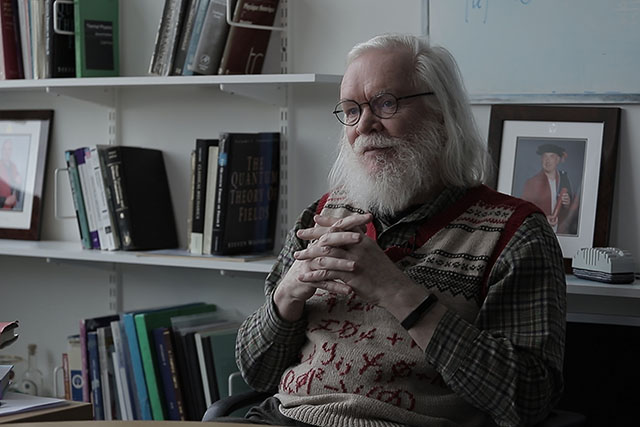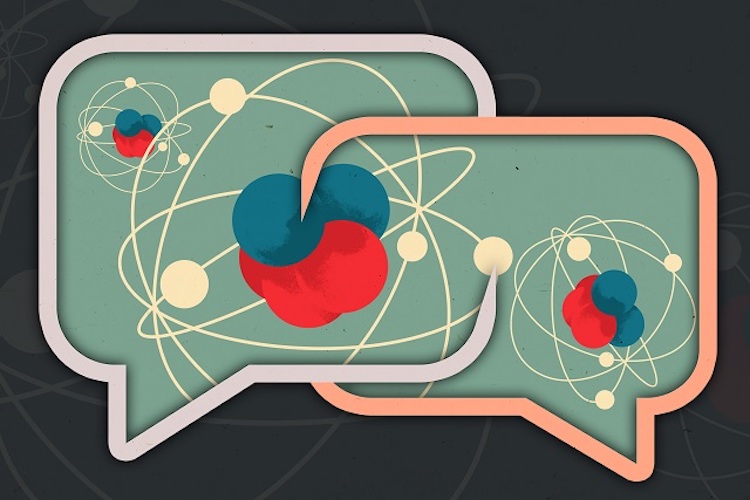Higgs Boson
Physicist John Ellis on what the Higgs boson is and the history of its discovery
videos | August 20, 2019
Why do atoms exist? Why is radioactivity such a weak force? If it wasn’t weak life would be impossible. So we know that atoms are made up out of electrons which are in a cloud around a central nucleus. But why do they stick around and form a cloud? Why don’t they just fly away? If they didn’t have any mass they would always travel at the speed of light and there would be no way to glue them together with a nuclei to make atoms. So we need to understand where the electron gets its mass. Why are the weak forces responsible for radioactivity so weak? They’re weak because the particle that generates those forces is very heavy. Why is it heavy? Where does its mass come from?
This is the big puzzle that faced physicists in the 1960s: where do particle masses come from? There was a theory proposed by Peter Higgs and colleagues in 1964 which predicted that there would be a universal field throughout all of space and there would be a quantum of that field that came to be called the Higgs boson. That Higgs boson was indeed discovered at CERN at the Large Hadron Collider in 2012.
Let’s go back to 1964. At that time people were just beginning to understand what we call the Standard model of particle physics (which you can see on my pullover). We knew about the electron, we were just beginning to understand that inside the nuclei there were things called quarks, and people were just beginning to write down theories of the fundamental interactions, like the top line of my pullover. But there was a puzzle. Where did those particle masses come from? Several groups of theoretical physicists were working on this problem and they were borrowing ideas from other areas of physics, in particular, the theory of superconductivity. They took over those ideas and brought them into the area of particle physics. The most famous of those is Peter Higgs but he wasn’t the first. Shortly before him two Belgian theorists, François Englert and Robert Brout, proposed a very similar idea and then many other people came along afterwards.
What’s the idea? We’re familiar with the idea of a field. We talk about a gravitational field: the gravitational field of the Sun keeps the Earth in its orbit. We’re familiar with electromagnetic fields: we know about electric charges, they generate fields, two charges attract if they’re opposite and repel when they’re the same. So they used this idea that there is this thing that we call a field that extends through space. What Englert, Brout and Higgs proposed was a new type of field, represented by φ on my t-shirt, which was different from the gravitational and electromagnetic fields. it’s constant throughout all the space, it’s the same in all directions, it’s completely homogeneous, isotropic and universal. According to this theory, particles get their masses from interacting with this universal field.
I’m not going to go to the mathematics of it but I will give you an analogy for thinking about it. Imagine that you are in Siberia in the middle of winter. So you’ve got this universal layer of snow, absolutely everywhere. And imagine that you’re trying to cross Siberia. If you’re lucky you can have skis and you go skimming very fast across the top, and that’s like a particle: think, for example, about the photon, the particle of light that does not interact with the Higgs field and it always travels at the same very high speed. In the same way, the skier travels very fast because he does not sink into the snow: the analogy is that it doesn’t interact with that Higgs snowfield. But maybe you don’t have skis; maybe you have snowshoes. Then you’re gonna go more slowly, you’re going to sink into the snow: that’s like a particle that interacts with the Higgs field, and because it interacts with the Higgs field it goes more slowly, it has a mass, it travels slower than the speed of light. And of course, it’s possible that maybe you try to walk across Siberia in your boots. If you do that you’re gonna go very very slowly because you interact very strongly with the snowfield: the analogy would be with a particle that interacts very strongly with this universal Higgs field and always travels much slower than the speed of light. So that’s the theory: your mass depends on how strongly you interact with this universal Higgs field. Mathematically it’s represented by the third line on my pullover.
How do you test this idea? Well, what is snow made of? What’s the quantum of snow? Snowflake. So analogously there is a quantum, the smallest unit of this Higgs field. That’s what we call the Higgs boson because amongst all the people who proposed the idea back in 1964 he was the only one who specifically pointed out the necessary existence of this particle. Of course, there are many different shapes of snowflakes and that’s because snowflakes are made up out of water molecules which you can arrange in different ways. In the same way, we’re still arguing about whether there is just one Higgs boson or whether there’s many many different types of Higgs boson or related particles which are made up by rearranging some sort of more elementary constituent in different ways. For the moment we’ve only seen one Higgs boson and it looks as if it’s an elementary particle.
So this idea was proposed in 1964 but people didn’t pay a lot of attention. Together with two colleagues, Mary Gaillard and Dimitri Nanopoulos, in 1975 we were perhaps the first to look at the Higgs boson systematically to try to figure out what it would look like in an experiment. At that time, in the 1970s, these ideas were still regarded as being quite speculative and so we actually noted in our paper we didn’t want to encourage big experimental searches for this particle. Fortunately, our advice was not taken. In the 1990s and 2000s, people built the Large Hadron Collider at CERN, so it collides protons at very high energies, it can make all sorts of the new particles. It had many different scientific objectives but one of the principal objectives of the Large Hadron Collider was to look for the Higgs boson and try to establish once and for all, does this mythical particle exists or not.
The Large Hadron Collider started making high energy collisions in 2010 and gradually in 2011 and the beginning of 2012 rumours started going around that maybe two of the experiments called ATLAS and CMS were perhaps seeing evidence for something that might be the Higgs boson. Finally, on July 4th 2012 there was a big seminar at CERN where the ATLAS and CMS experiments both announced that they had discovered a new particle which looked like it had the right properties to be the Higgs boson. As you can imagine, this was a really big event in the world of particle physics. Peter Higgs came to this presentation of these results and he had a little bit of tears on his eyes. He said afterwards that he’d never expected to see this particle discovered in his lifetime.
On July 4th 2012 we knew we discovered a new particle but we could not be sure that is was the Higgs boson. We had to check that it had the right properties: for example, it should couple to other particles proportional to their mass, so we had to check that. Together with my student Tevong You, we analysed the data: everything looked good. There were other properties of the Higgs boson that needed to be checked and finally in 2013 everybody was convinced and Peter Higgs and François Englert got the Nobel prize in 2013.
Now we have in our hands this particle called the Higgs boson. We’re checking its properties to see maybe there’s some sort of deviation from the predictions of the Standard model; we’re looking to see whether there’s maybe other Higgs bosons, we want to understand why the Higgs boson has the mass that it does. All these are open questions that remain to be studied.





























